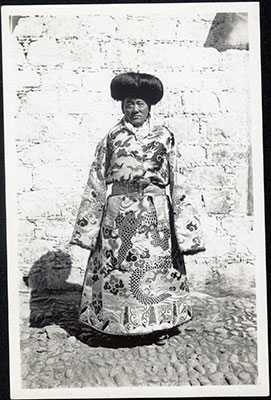
1998.131.470.1 (Contact Print)


1998.131.470.1 (Contact Print)

Frederick Spencer Chapman
Frederick Spencer Chapman
February 12th 1937
Lhasa > Dekyi Lingka
1998.131.470.1
91 x 60 mm
Print gelatin silver
Donated 1994
Faith Spencer Chapman
British Diplomatic Mission to Lhasa 1936-37
Frederick Spencer Chapman
A.7 [view film roll]
SC.T.2.470
Notes on print/mount - The contact print has been made using Velox paper, the trade name being printed in an oval. The number '16' (circled) has been written on the back in pencil. Chapman has written his signature on the back of the print in pencil ('F. S. Chapman'). The number 640 has been printed on the back in red ink [MS 30/6/2005]
Manual Catalogues - Caption in Chapman's hand-written list of negatives made whilst on the Mission to Lhasa, 1936-7 [See PRM Manuscripts Collection]: '1/2 Tsarong in special dress'; PRM Manuscripts Collection: ‘List of Tibetan Prints and Negatives’ - Book 3: ‘11/1 - Tsarong Dzasa in a New year’s robe of silk and brocade from Russia. The hat is scarlet’ [New Year] [MS 27/03/2006]
Biographical Information - [Note that detailed information will be found on the related file named Biographies, see button at top of database] Tsarong had been a Shap-pe (cabinet minister in the Tibetan government) but at the time of the British Mission in 1936 he controlled Trapchi, The Government Barracks, Arsenal and Mint and was powerful in the National Assembly. [Marina de Alarcón ZF 1995.5]
Biographical Information - Dasang Damdul Tsarong was a favourite of the 13th Dalai Lama, a military man and later a shappe (cabinet minister in the Tibetan government) until he was removed from office as a result of his modernising policies. He was a great friend of the British Mission frequently inviting them to his house and accompanying them on their various visits around Lhasa. He was considered by the mission to be a great character, as Gould recalled “Once, after a long and festive party at the De Kyi Lingka, he fell asleep in my arms murmuring, “Great minister, I love you, I love you”. At breakfast next morning he had his usual bright eye and was quite unperturbed. He spoke a little English. To him it seemed strange that anybody in India should not welcome British rule” [1957:236]. He had four wives (including Rigzin Choden, Pema Dolkar, Rinchen Dolma (later Mary Taring) and Tseten Dolkar) and ten children. Although he was in India in 1956 he insisted on going back to Tibet to help the Dalai Lama to escape into exile. He was captured by the Chinese and in 1959 died mysteriously the night before what was due to be his public humiliation. [CH, 2003]
Other Information - Related Images: Images prefixed with 'A' comprise a group of negatives containing images of officials and the Regent riding in ceremonial dress up to the Potala taken during the New Year ceremonies at Lhasa [MS 27/03/2006]
Other Information - Dress: Silk brocade outer garments of this kind could only be worn by officials above the 6th Rank [Marina de Alarcón ZF 1995.5]
Other Information - Dress: This picture was taken at the start of the New Year celebrations when, as Chapman recalls in "Lhasa: The Holy City", all lay-officials wore their finest clothes: "I had the impression of watching some gay medieval pageant, some fantastic Hollywood production, or a throng of people in fancy dress... Tsarong wore a glistening brocade dress with a multicoloured pattern of scaly dragons." [CH 03/04/2000]
Other Information - Dress: Chapman reported in the official mission diary for 12th February 1937 that this costume reputedly cost him two thousand rupees. However, Tsarong's son Dundul Namgyal Tsarong [see 1998.131.485, 1998.131.486 and 1998.157.85] wrote in his biography of his father that when Tsarong was first promoted to high rank he struggled to be able to afford the formal accoutrements of his new position: "At this time, Father had very little resources and His Holiness supplied him with the entire wardrobe, including formal robes, hats, boots, etc, that is required of a Dzasak [government official ranked directly under that of a Cabinet official or shappe ]. Government officials of all ranks wore very elaborate costumes at formal functions, which amounted to quite an expense. His Holiness gave him religious images, a rosary, horses, saddles and two Tibetan seals bearing his title. He then sent Father off to the house of Tsarong with his blessing" [ In the Service of his Country: the Biography of Dasang Damdul Tsarong, Commander General of Tibet , Dundul Namgyal Tsarong, Ithaca, New York: Snow Lion Publications, pp. 47-8] [MS 30/6/2005]
Other Information - Setting: This photograph was probably taken on the 12th of February 1937. February 12th was the first day of the Tibetan New Year or Losar , and Chapman wrote in the official diary of the mission, for which he was responsible as Mission Secretary, that on that day "As soon as we got home after our visit to the Potala Tsarong came to present a scarf of greeting and a small gift to each of us. He was wearing a special ceremonial dress of very heavy silk brocade with a large pattern of dragons and flowers; we discovered later that it had cost him 2000 rupees". [MS 30/6/2005]
For Citation use:
The Tibet Album.
"Tsarong at New Year"
05 Dec. 2006. The Pitt Rivers Museum.
<http://tibet.prm.ox.ac.uk/photo_1998.131.470.1.html>.
For more information about photographic usage or to order prints, please visit the The Pitt Rivers Museum.
© The Pitt Rivers Museum